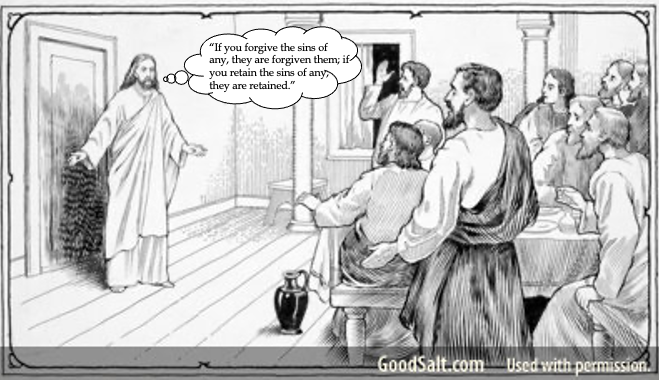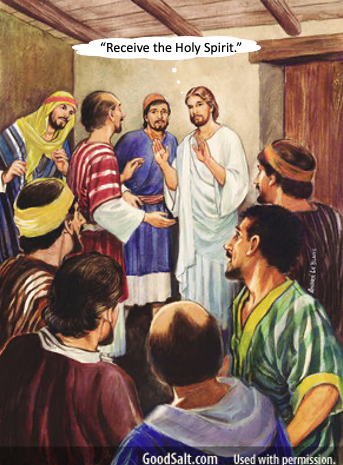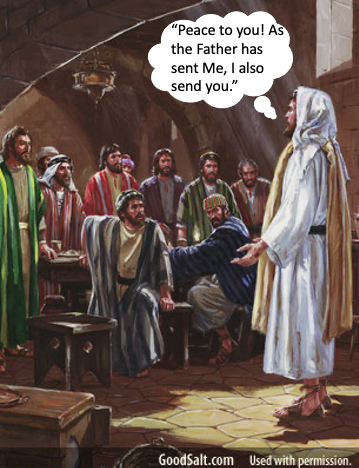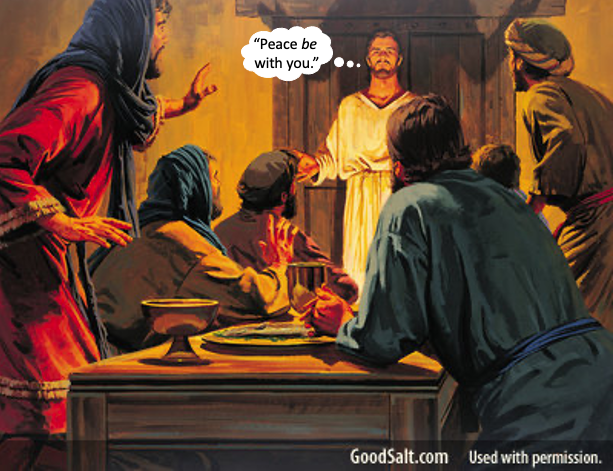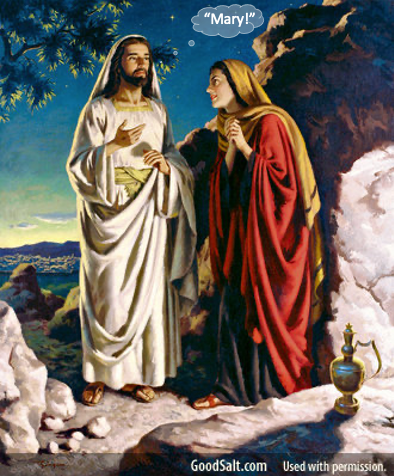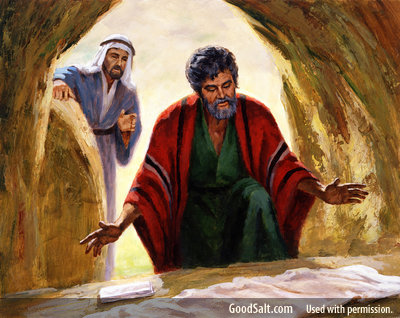“Then the other disciple, who came to the tomb first, went in also; and he saw and believed.” John 20:8
Today we will continue to look at how the empty tomb of Jesus challenged the life of Mary Magdalene. From this we will see how Jesus’ resurrection can make a difference in our daily lives. We discovered last time that Jesus will dispel the darkness in our lives with the light of His resurrection (John 20:1). The next way Christ can make a difference in our daily lives isto PROVIDE EVIDENCE OF HIS RESURRECTION FOR OUR MINDS (John 20:2-9).
As we celebrated Jesus’ resurrection last month, those of us who believe in Jesus as our Savior were filled with joy as we sang and worshiped our risen Lord! However, it may be difficult for us to realize what it was like for those who discovered the empty tomb on that first resurrection Sunday. When Mary Magdalene saw that the tomb was empty, she wasted no time and “ran” to Peter and John, “the other disciple, whom Jesus loved” to tell them that “they [the religious leaders] have taken away the Lord out of the tomb” (John 20:2b).
Why didn’t Mary remember Jesus’ promise that He made before His crucifixion, saying He would rise from the dead on the third day (Matthew 16:21; 20:19)? Why didn’t Mary relay the message of the angel announced to her (and the other women) earlier that morning, that Jesus had risen (cf. Matthew 28:1-8; Luke 24:1-10)? Mark’s account tells us that fear had overcome Mary, so she said nothing to anyone (Mark 16:8). Since Mary was a former demon possessed person, she may have feared people would easily suspect her of having hallucinations (cf. Mark 16:9; Luke 8:2). She may have thought that the angels were actually men who took Jesus’ body. What would that be like to conclude that the body of the One you followed and revered was stolen from His grave?
In 1876, a gang of counterfeiters from Chicago attempted to steal the dead body of President Abraham Lincoln and hold it for ransom. Even though their attempt to steal Lincoln’s remains failed, it led to Lincoln’s corpse being buried again in Springfield, Illinois, in a steel cage under tons of cement so that it would not happen again. When the rest of the nation found out about this failed attempt to steal the President’s remains, it was in shock that a leader like that would be defiled in that kind of way. 1
That is probably how Mary and the disciples of Jesus must have felt. Their response is not uncommon. Even for us, when we first discover the shocking truth of the resurrection of Christ, we may have more confusion or doubt than we have joy or hope. For example, when we attempt to apply the truth of Christ’s resurrection to our lives, we may have confusion – “How does Jesus’ resurrection apply to my situation?” Or we may have fear – “I’m afraid of what this power might do in my life.” Or we may even have doubt– “I don’t know if this power will work in my life.” For Mary it was confusion (John 20:2). For the disciples in the Upper Room it was fear (John 20:19). For Thomas it was doubt (John 20:24-25).
Notice Mary said, “They have taken away the Lord out of the tomb” (John 20:2b). Often when it comes to the resurrection of Jesus and how that resurrection can apply to our lives, the hope is right there in front of us. We just cannot see it yet. How can I start to see the resurrected Jesus there where I am confused?
When Mary informed Peter and John of the empty tomb, they wasted no time talking. They ran toward the tomb. “Peter therefore went out, and the other disciple, and were going to the tomb. So they both ran together, and the other disciple outran Peter and came to the tomb first” (John 20:3-4). These verses are captivating because of their eyewitness nature. John probably wrote these verses thirty-five years after it happened, before A. D. 70. 2 But as we read this almost two thousand years later, it reads like it happened today. Like he just saw it. If this happened to me, I would not forget it either. It is almost funny to read this eyewitness account because it is so fresh and real to John. Even though it is thirty-five years later, John wants his readers to know he was faster than Simon Peter. That sounds like someone else I know – me!
Even though John arrived at the empty tomb first, he does not go into the tomb. “And he, stooping down and looking in, saw the linen cloths lying there; yet he did not go in.” (John 20:5). John seems to wait at the entrance to process what he sees as quickly as possible. “Why would the linen wrappings be here without the body? Is there any sign of forced entry? Any indication of foul play? Where is the body? What has happened here?” 3
“Then Simon Peter came, following him, and went into the tomb; and he saw the linen cloths lying there, and the handkerchief that had been around His head, not lying with the linen cloths, but folded together in a place by itself.” (John 20:6-7). Peter pushes his way past John, as if to say, “Out of the way John. I’ve got to go in there to see what has happened.” That’s just the way Peter was. Peter also saw thestrips of “linen cloths lying there” where the body of Jesus had been placed and he also saw “the handkerchief that had been around His head.” Instead of being tossed aside, it was “folded together in a place by itself.” The fact that this head piece was “not lying with the linen cloths” suggests that Jesus first unwrapped the face cloth and folded it, set it down, and then unwrapped the rest of His grave clothes. The fact that the grave clothes were not in disarray and that the headpiece was neatly folded, demonstrates that the body was not stolen. Grave robbers would have been in a hurry and either taken the body with the wrappings or would have ripped and scattered them. Thieves would not have been this careful. 4 “Neither would friends who might have removed the body done this; they would have hurried away from the tomb as quickly as possible to avoid being apprehended.” 5
Carson observes, “The description is powerful and vivid, not the sort of thing that would have been dreamed up; and the fact that two men saw it (v. 8) makes their evidence admissible in a Jewish court (Dt. 19:15).” 6
Also this eyewitness description refutes the attempt to explain away Jesus’ resurrection (The Swoon Theory) by saying Jesus did not really die on the cross, He merely fainted and then was later revived in the tomb. “This theory proposes that after enduring the intense brutality of being beaten and crucified, Jesus was revived by the cool interior of the tomb. But this doesn’t explain why a half-dead man would remove his head cloth, neatly fold it, and place it separate from his intact linen wrappings! Nor does it explain how he could have had the strength to move the heavy stone blocking the entrance. As with other attempts by unbelievers to deny the resurrection, this one fails to adequately explain the evidence. One thing is clear: When the disciples saw Jesus later (see 20:19-23), he didn’t look like a man who had been merely resuscitated from a near death experience!” 7
John now goes into the tomb. “Then the other disciple, who came to the tomb first, went in also; and he saw and believed.” (John 20:8).What did John “believe?” Mary’s report that the tomb was empty? Doubtful. When John saw that Jesus’ body was missing and the position of His grave clothes, he believed Jesus had risen from the dead. The evidence persuaded him to believe Christ was alive. Earlier in John’s gospel after Jesus had cleansed the temple and said, “Destroy this temple, and in three days I will raise it up” (John 2:19), John wrote, “But He was speaking of the temple of His body. Therefore, when He had risen from the dead, His disciples remembered that He had said this to them; and they believed the Scripture and the word which Jesus had said.” (John 2:21-22). John had already believed Jesus was the Christ, the Son of God, that believing he may have eternal life in Jesus’ name (John 2:11; 6:69; 13:10; cf. 20:31). But when he saw the empty tomb and the arrangement of Jesus’ grave clothes, he believed Jesus rose from the dead. The evidence of Jesus’ resurrection convinced John even before he encountered the risen Lord Jesus. People since John can believe in Christ because of this evidence, too, even though they have not yet seen the risen Jesus (cf. John 20:29; 1 John 1:1- 4). 8
If you and I are going to see Jesus’ resurrection in our daily lives, we need evidence for our minds. For example, when you say, “I believe Jesus Christ rose from the dead,” how do I know you are not making that up? What makes that statement any different than saying, “I believe that the scrambled eggs I ate this morning have the power to change my life?” What makes it any different? Evidence. Something amazing happened in that tomb.
There are three different Greek words used for “saw” in these verses (John 20:5-6, 8). When we are told that John bent down and “looked in” the tomb, the word for “saw” [blépō, βλέπω] is used which is a common Greek word meaning to “perceive with the eye” (John 20:5). 9 In this context, it conveys the idea of John bending down to glance or look quickly into the tomb. 10 When Peter entered the tomb, the word John uses for “saw” [theōréō, θεωρέω] refers “to observing something with sustained attention” 11 or “careful observation” 12(John 20:6). Peter carefully observed the contents inside the tomb. This is the word that we get the English word “theorize” from. When Peter saw the linen cloths lying there, he was thinking it through, wondering what was happening. He was coming up with a theory. The third word John used for “saw” [horáō, ὁράω] means “to be mentally or spiritually perceptive,”(John 20:8). 13 Peter saw more after entering the tomb than John did in his first glance from outside the tomb, but John saw into the meaning of it all better than Peter. 14 Peter had more sight, but John had more insight. The evidence of Christ’s resurrection convinced John even before he met the resurrected Jesus.
These verses describe three different ways of seeing the truth of Jesus’ resurrection. I can take the truth of Jesus’ resurrection and just glance at it as I run by. Or I can gaze at it and try to figure it out. But the third way, the way John saw, is I can get it. John looks at the evidence and sees what has happened, and is persuaded to believe Jesus rose from the dead. We have had this happen with spiritual truth. It is when the truth is perceived in our minds so that it becomes real in our lives.
Hebrews 11:1 says, “Now faith is the substance of things hoped for, the evidence of things not seen.” Faith is defined as “the substance” or confident assurance “of things hoped for.” It is “the evidence” or conviction about “things not seen.” Through faith, the unseen becomes seen. The invisible become visible. John did not have to see the risen Lord Jesus to be convinced He was alive. He saw the evidence and was persuaded that Christ had come back to life.
Some people think that to have faith means you stop thinking. But we cannot believe in something that our mind rejects. Christianity is reasonable because it is based on historical facts. The resurrection of Christ makes sense when you start to look at what really happened. It is not true that there is no evidence for our faith. There are a number of very strong evidences for the resurrection of Jesus Christ.
First, we have the historical record. The historical reliability of an ancient document is determined by the number of manuscripts and the time interval between the original and earliest copy. The more manuscripts and the shorter the time gap between the original and earliest copy, the greater the historical reliability of the document. When comparing the New Testament with other famous ancient writings, the New Testament has far more manuscript authority than any other ancient literature. For example, the New Testament has 5,686 surviving Greek manuscripts compared to the most documented secular work from the ancient world, Homer’s Iliad, which has 643 surviving manuscript copies. 15 Most books from the ancient world have surviving manuscript copies about one thousand years after they were originally composed, with the Odyssey having one manuscript copied five hundred years after the original. But the New Testament survives in complete books from a little over 150 years after the original. 16 No other book from the ancient world has a smaller time gap between the original and the earliest copies as the New Testament. 17
Most (if not all) of the New Testament books were written by eyewitnesses and contemporaries of Jesus and His ministry (A.D. 29-33). For example, the gospel writers include, Matthew, who was accustomed to taking accurate records as a tax collector (Matthew 9:9), and was a disciple and observer who provides long and direct quotes from Jesus (cf. Matthew 5-7; 13; 23-25). Mark was a disciple of Peter (I Peter 5:13) who was an eyewitness of Christ (2 Peter 1:16). Luke was an educated contemporary of Christ who said, “Just as those who from the beginning were eyewitnesses and ministers of the word delivered them to us, it seems good to me also, having had perfect understanding of all things from the very first, to write to you an orderly account” (Luke 1:2-3). John the apostle was a direct eyewitness of Jesus (John 19:35; 21:24; cf. I John 1:1-4). In addition to the gospel writers, Peter was also a direct eyewitness (2 Peter 1:16) and Paul was a contemporary of Christ and a witness of Jesus’ resurrection (I Corinthians 15:8). 18
The early dating of the New Testament manuscripts supports their truthfulness. The most knowledgeable scholars date the New Testament books within the lifetime of the eyewitness writers and contemporary authors. Noted Archaeologist Nelson Glueck wrote, “We can already say emphatically that there is no longer any solid basis for dating any book of the New Testament after about A.D. 80.” 19 William F. Albright, the distinguished paleographer, said that “every book of the New Testament was written by a baptized Jew between the forties and the eighties of the first century A.D. (very probably between about A.D. 50 and 75).” 20
Luke claims to be a careful contemporary historian of the events he records, saying, “having had perfect understanding of all things from the very first, to write to you an orderly account… that you may know the certainty of those things in which you were instructed.” (Luke 1:3-4). “After spending many years researching the area, the noted expert on the first-century Near East, Sir William Ramsay, concluded that Luke was a first-rate historian. For in reference to thirty-twocountries, fifty-four cities and nine islands he did not make a single mistake!” 21
“The New Testament writers were honest men who willingly died for what they believed. And they were careful to distinguish their words from those of Jesus, revealing that they were not inventing them but reporting them (Acts 20:35; I Cor. 7:10, 12, 25; Rev. 1:17-20; 2:1f; 3:1f; 22:16-20). The New Testament is markedly different from Christian folklore, such as is found in the second- and third-century Christian apocryphal books. Noted Oxford expert on literature and myths, C.S. Lewis, insightfully notes about New Testament critics: 22
“’I distrust them as critics. They seem to me to lack literary judgment, to be imperceptive about the very quality of the texts they are reading… If he tells me something in a Gospel is legend or romance, I want to know how many legends and romances he has read. I have been reading poems, romances, vision-literature, legends, myths all my life. I know what they are like. I know that not one of them is like this [the Gospels].” 23
Although some skeptics claim the New Testament is dependent on earlier sources, the evidence shows the New Testament is “clearly a firsthand, first-century account by disciples and contemporaries of Jesus. And contrary to widely believed liberal myths, each account is independent. Everyone acknowledges the difference between and independence of John and Luke, which is all that is necessary to manifest their authenticity. And even though it is unnecessary for the overall argument in defense of the authenticity of the basic life and words of Christ, a good case can be made for the independence of the Synoptic Gospels (Matthew, Mark, and Luke) as well.” 24
The science of archaeology has verified the historical accuracy of the Gospel records as well. Renowned Archaeologist, Nelson Glueck concluded, “It may be stated categorically that no archaeological discovery has ever controverted a Biblical reference. Scores of archaeological findings have been made which confirm in clear outline or exact detail historical statements in the Bible.” 25
Sir William Ramsay, whose change from a skeptical view of the New Testament to a converted view was supported by a lifetime of research in the Near Eastern world. He writes, “I began with a mind unfavorable to it [Acts], for the ingenuity and apparent completeness of the Tubingen theory had at one time quite convinced me. It did not lie then in my line of life to investigate the subject minutely; but more recently I found myself often brought in contact with the book of Acts as an authority for the topography, antiquities, and society of Asia Minor. It was gradually borne in upon me that in various details the narrative showed marvelous truth.” 26
Renowned historian Colin Hemer has demonstrated the historical accuracy and authenticity of the New Testament in an amazing way. His research shows: “1) that the Book of Acts was written no later than A.D. 62; 2) that it is minutely accurate history written by an eyewitness and contemporary of the events of Jesus’ life; 3) that the same highly accurate contemporary historian, Dr. Luke, also wrote a Gospel (cf. Acts 1:1 and Luke 1:1) which tells the same basic story as the other Gospels, namely, that Jesus claimed to be and proved to be the Son of God by numerous incredible miracles, and that He died on the Cross and rose from the grave three days later. This is of course a strong confirmation of the central Christian message… So Luke’s narrative of the life and miracles of Christ must likewise be accepted as authentic. And since Luke’s narration of Christ’s life and miracles in it accord with that of the other Gospels, we have here an archaeological confirmation of the Gospels that record the miracles and resurrection of Christ. In brief, from a strictly historical point of view, we could not have better evidence for the authenticity of events than we possess for the events in the life of Christ recorded in the New Testament.” 27
Having established the historical reliability of the New Testament, let’s listen to Its testimony regarding Jesus’ resurrection. “Concerning His Son Jesus Christ our Lord, who was … declared to be the Son of God with power… by the resurrection from the dead.” (Romans 1:3-4). The proof that Jesus rose from the dead was that He was seen alive after His death by over five hundred eyewitnesses (I Corinthians 15:5-8). Listen to what a former persecutor of Christianity, named Paul, wrote in the Bible. “3 That Christ died for our sins according to the Scriptures, 4 and that He was buried, and that He rose again the third day according to the Scriptures, 5 and that He was seen by Cephas, then by the twelve. 6 After that He was seen by over five hundred brethren at once, of whom the greater part remain to the present, but some have fallen asleep.” (I Corinthians 15:3-6).
“The reason these facts are so significant is because of who Christ is and what his death accomplished. Jesus Christ is the God-man. He is the Word of God who became flesh (John 1:14). He is the Son of God, the second Person of the Godhead, who became a man without giving up his deity (see Phil 2:5-8). He is the one and only person with both a divine nature and a human nature, unmixed forever. Therefore, he could serve as a perfect substitutionary sacrifice for sinners because as God he is without sin, and as a man he could die in our place. By bearing our sins on the cross, he suffered the wrath of God that we deserved so that we might be forgiven, receive eternal life, and be saved (see, e.g., 2 Cor 5:21; 1 Pet 2:24).” 28
Notice the phrase “Christ died for our sins according to the Scriptures.” Hundreds of years before Jesus came to earth, the prophet Isaiah predicted in the Old Testament Scripture that the Messiah would die for our sins when he wrote, “He was wounded for our transgressions, He was bruised for our iniquities.” (Isaiah 53:5). When Jesus died on the cross, He fulfilled Isaiah’s prophecy. The proof that Jesus died was “that He was buried.” Christ did not merely swoon or faint on the cross. He died on that cross. We do not bury a living person, we bury a dead person.
Next, we see that Jesus “rose again the third day according to the Scriptures.” The verb “rose” (egēgertai) is in the perfect tense in the original language, and it means Jesus rose from the dead in the past and He remains risen today. You will never hear a news report today that says Jesus’ dead body has been found. Why? Because He is risen and He remains alive today!
“Jesus suffered and died on our behalf; he made payment for our sins. Was this payment accepted? We can be certain that it was because God raised him from the dead. This is the clear and consistent testimony of the early church (see, e.g., Acts 2:24-32; 3:15; 5:30; 10:39-41; 13:29-37; 17:31). Jesus has risen from the grave, and the apostles and many others were eyewitnesses to this. The resurrection, then, is your receipt that God accepted Christ’s payment for your sins and mine.” 29
Notice the phrase, “according to the Scriptures.” Jesus’ resurrection also fulfilled Old Testament Scriptures written hundreds of years before Christ came to earth. In Psalm 16:10, King David wrote, “For You will not leave my soul in Sheol, nor will You allow Your Holy One to see corruption.” On the day of Pentecost in Acts 2, a follower of Jesus named, Peter, said that when Jesus rose from the dead, He fulfilled what David wrote hundreds of years before. “Men and brethren, let me speak freely to you of the patriarch David, that he is both dead and buried, and his tomb is with us to this day. Therefore, being a prophet, and knowing that God had sworn with an oath to him that of the fruit of his body, according to the flesh, He would raise up the Christ to sit on his throne, he, foreseeing this, spoke concerning the resurrection of the Christ, that His soul was not left in Hades, nor did His flesh see corruption. This Jesus God has raised up, of which we are all witnesses.” (Acts 2:29-32).
Keep in mind that the Old Testament not only predicted the death and resurrection of Christ, but Jesus also predicted His own death and resurrection on several occasions. In the earliest part of His ministry He said, “Destroy this temple, and in three days I will raise it up.” (John 2:19). John explains, “But He was speaking of the temple of His body. Therefore, when He had risen from the dead, His disciples remembered that He had said this to them; and they believed the Scripture and the word which Jesus had said.” (John 2:21-22). Later in Matthew 12:40, Jesus said, “For as Jonah was three days and three nights in the belly of a great fish, so will the Son of Man be three days and three nights in the heart of the earth.” To those who had witnessed His miracles and stubbornly refused to believe in Him as the Messiah, He said more than once, “An evil and adulterous generation seeks after a sign, and no sign will be given to it except the sign of the prophet Jonah” (Matthew 12:39; 16:4). After Peter’s confession of Jesus as “the Christ” (Mark 8:29), Jesus “began to teach them that the Son of Man must suffer many things, and be rejected by the elders and chief priests and scribes, and be killed, and after three days rise again.” (Mark 8:31). This became a primary part of Jesus’ teaching from that point until His death (Mark 9:31; 10:33-34; 14:58; Matthew 27:63). In addition Jesus taught that He would raise Himself from the dead, saying of His life, “No one takes it from Me, but I lay it down of Myself. I have power to lay it down, and I have power to take it again.” (John 10:18). 30
“Famous philosopher of science, Karl Popper, argued that whenever a ‘risky prediction’ is fulfilled, it counts as confirmation of the theory that comes with it. If so, then the fulfillment of Jesus’ prediction of His own resurrection is confirmation of His claim to be God. For what could be riskier than predicting your own resurrection? If a person will not accept that as evidence of a truth claim, then he has a bias that will not accept anything as evidence.” 31
Finally, in I Corinthians 15, we see the proof that Jesus rose from the dead was that He was “seen” by “over five hundred” eyewitnesses “at once, of whom the greater part remain to the present.” Most of these eyewitnesses were still alive when Paul wrote this two decades after Jesus’ resurrection, so they could verify the reliability of the evidence for Jesus’ resurrection. 32 This was not a conspiracy invented by a small group of people! Hundreds of people saw Jesus alive after His crucifixion!
While Jesus appeared to this crowd of over five hundred people in His resurrected body on one occasion, the historical record also shows that Jesus appeared in His resurrection body to people on twelve different occasions over a forty-day period (Acts 1:3). Luke writes of Jesus, “He through the Holy Spirit had given commandments to the apostles whom He had chosen, to whom He also presented Himself alive after His suffering by many infallible proofs, being seen by them during forty days and speaking of the things pertaining to the kingdom of God.” (Acts 1:2b-3).
“The disciples didn’t have a corporate delusion. Nor did they see a ghost. Jesus proved to them that he was the same flesh and blood man who had been crucified and buried—though he’d since gained a glorified body (see Luke 24:36-43).” 33
When the twelve different appearances of Jesus in His resurrection body are examined, we discover that Christ was seen and heard with the natural senses of the observer – Mary Magdalene (John 20:10-18), Mary and the women (Matthew 28:1-10), Peter (I Corinthians 15:5), the two disciples on the road to Emmaus (Luke 24:13-25), the ten apostles (Luke 24:36-49; John 20:19-23), the eleven apostles (John 20:24-31), the seven apostles (John 21), all the apostles (Matthew 28:16-20; Mark 16:14-18), the five hundred brethren (I Corinthians 15:6), James (I Corinthians 15:7), all the apostles (Acts 1:4-8), and Paul (Acts 9:1-9; I Corinthians 15:8). On four different occasions He was either touched (John 20:10-18; Matthew 28:1-10) or offered to be touched (Luke 24:36-49; John 20:19-23; 24-31). Four times Jesus ate physical food with His disciples (Luke 24:13-35; 36-49; John 20:19-23; 21:1-15). Four times they saw Jesus’ empty tomb (John 20:1-18; Matthew 28:1-10; I Corinthians 15:5) and two times He showed them His crucifixion scars (Luke 24:36-49; John 20:19-23; 24-31). 34 Jesus “literally exhausted the ways possible to prove that He rose bodily from the grave. No event in the ancient world has more eyewitness verification than does the resurrection of Jesus.” 35
Those who question the reliability of the New Testament writers and eyewitnesses concerning the resurrection of Christ because they assume they were predisposed to believe the resurrection events to which they gave testimony, need to consider the following:
“First, the apostles themselves did not believe the testimony of others that Christ had risen from the dead. When the women reported it, ‘their words seemed to them like idle tales, and they did not believe them’ (Luke 24:11). Even when some of the disciples saw Christ themselves they were ‘slow of heart to believe ‘ (Luke 24:25). Indeed, when Jesus appeared to ten apostles and showed them his crucifixion scars, ‘they still did not believe for joy, and marveled’ (Luke 24:41). And even after they were convinced by Jesus’ eating of food, their absent colleague Thomas protested that he would not believe unless he could put his finger in Jesus’ hand (John 20:25).
“Second, Jesus not only appeared to believers; he also appeared to unbelievers. He appeared to his unbelieving half-brother James (John 7:5; I Corinthians 15:7). Indeed, he appeared to the greatest unbeliever of the day – a Jewish Pharisee named Saul of Tarsus (Acts 9). If Jesus had only appeared to those who were either believers or with the propensity to believe, then there might be some legitimacy to the charge that the witnesses were prejudiced. But just the opposite is the case.
“Third, the witnesses to the resurrection had nothing to gain personally for their witness to the resurrection. They were persecuted and threatened with death for their stand (Acts 4, 5, 8). As a matter of fact, most of the apostles were martyred for their belief. Certainly, it would have been much more profitable personally for them to deny the resurrection. Rather, they proclaimed and defended it in the face of death.
“Fourth, to discount their testimonies because they believe in the resurrected Christ is like discounting an eyewitness of a murder because he actually saw it occur! The prejudice in this case is not with the witnesses but with those who reject their testimony.” 36
So far we have talked about the historical record of the New Testament regarding the death and resurrection of Christ. What do non-Christian historians and writers from the first and second centuries say about the death and resurrection of Christ? Jewish historian, Josephus, wrote of Jesus’ death, “Pilate, at the suggestion of the principal men among us, had condemned him to the cross.” 37 Roman historian, Cornelius Tacitus, wrote, “a wise man who was called Jesus…. Pilate condemned Him to be condemned and to die.” In addition he said that Jesus’ disciples “reported that He had appeared to them three days after His crucifixion and that He was alive.” 38 A Roman writer, Phlegon, referred to Christ’s death and resurrection in his Chronicles, saying, “Jesus, while alive, was of no assistance to himself, but that he arose after death, and exhibited the marks of his punishment, and showed how his hands had been pierced by nails.” 39 In addition, Phlegon spoke of “the eclipse in the time of Tiberius Caesar, in whose reign Jesus appears to have been crucified, and the great earthquakes which then took place.” 40
The historical evidence for Jesus’ death is so overwhelming that even a Muslim scholar,Reza Aslan, who wrote the book, Zealot, was persuaded to conclude Jesus “was most definitely crucified.” 41 Despite what the Quran teaches, the historical evidence persuaded Aslan to conclude that Christ truly did die on the cross. “He believes so strongly in Jesus’ death by crucifixion that he uses it as the foundation for his entire theory of Jesus’ life.” 42
Just as history proclaims that George Washington was the first President of the USA, so history proclaims that Jesus Christ died and was resurrected from the dead. The resurrection of Christ is the most attested fact of ancient history. Thomas Arnold authored a three-volume history of Rome and was appointed to Oxford’s Chair of Modern History. Concerning the evidence behind the resurrection of Jesus Christ, he said, “I have been used for years to study the histories of other times, and to examine and weigh the evidence of those who have written about them, and I know of no one fact in the history of mankind which is proved by better and fuller evidence of every sort, to the understanding of a fair inquirer, than that Christ died and rose from the dead.” 43
Frank Morison, a British trial lawyer, vowed to write a book disproving Christianity and committed to base his book on a collection of facts. Using a critical method of evaluation and despite his initial beliefs, he concluded that Christianity is true. The resurrection convinced him, and he wrote a book entitled, Who Moved the Stone? which begins with the chapter, “The Book that Refused to Be Written.”
Former atheists Josh McDowell and Lee Strobel set out to disprove the resurrection of Christ only to be persuaded by the historical evidence that Jesus did indeed rise from the dead. You can read about the evidence that persuaded them to believe in Jesus in their books: McDowell ‘s The New Evidence that Demands a Verdict (1999) and The Resurrection Factor (1981); Strobel’s The Case for Christ Revised (2013) and The Case for Easter (2004).
The second evidence of Jesus’ resurrection is the change in the lives of His followers. His disciples were not shrewd men who figured out some weird way to start a new religion. They did not say, “Let’s get our Leader killed off. Then we’ll go hide out in an upper room and then all of a sudden we will have a new hope.” No. After Jesus’ death, these men were discouraged. They were hiding for fear of the Jews (John 20:19). And all of a sudden their lives were changed overnight! And they went out preaching the message of Jesus Christ without fear. They were not afraid of being arrested or of being put to death (Acts 3, 4, 5, 8, et al.). What happened to them? The resurrection of Jesus Christ.
The third proof of Jesus’ resurrection is the silence of Jesus’ enemies. If you were one of Jesus’ enemies (the Romans or Jewish religious leaders), and you have the disciples going around saying Jesus is alive and it is bringing people away from your faith to a new faith, what would you do to stop them? Go find the dead body! If you could find the dead body of Jesus Christ, it would bring this entire movement to a stop. But they couldn’t find the body. Why? Because there was no dead body to be found. They tried to make sure that the body would stay there in the tomb. They sealed the tomb and had Roman soldiers guard it to keep somebody from trying to get in to the tomb (Matthew 27:62-66). But they forgot that somebody would be getting out. And when Jesus burst out of that tomb in resurrection, there was no body there.
The final proof of Jesus’ resurrection is the changed lives of people today. Look at what the risen Lord Jesus is doing in the lives of people from every nation today! Former atheists and God-haters are coming to faith in Christ. Headlines read, “Life under ISIS led these Muslims to Christianity” (NBC News on February 3, 2019) and “Muslims Converting to Christianity in Unprecedented Numbers” (Open Doors on June 28, 2017). People who once hated the God of the Bible, are now loving Him because of the risen Lord Jesus Christ. People from all walks of life are coming to faith in the resurrected Lord Jesus Christ. And I am one of them!
You may say,“I believe in another religion. It has changed my life just like your belief in Jesus Christ. What’s the difference?” The difference is an empty tomb. The difference is Christians have a reality behind their faith. Their faith is based upon historical facts. It is not a man-made philosophy or superstition. We have evidence for our minds.
For the apostle John that evidence was very powerful. What did he see that made him believe? Was it the stone that was cast aside? No. Was it an angel? No. He saw the grave clothes lying there and he believed. There was something about the arrangement of the grave clothes. A lot of people say they were lying there as if Jesus had just evaporated out of them immediately. And because they were folded so neatly, not torn aside. Remember, the strips of linen would have been wrapped around the body. You couldn’t get a body out of that and leave it just lying there undisturbed. So when John saw that he believed. That evidence persuaded him to believe that Jesus rose from the dead.
I find verse nine to be very significant. “For as yet they did not know the Scripture, that He must rise again from the dead.” (John 20:9). The disciples did not yet understand the prophecies of Old Testament Scripture that indicated Jesus would rise from the dead. Their belief in the resurrection preceded their understanding that the resurrection was foretold in Scripture. The first believers did not manufacture a resurrection story to agree with their interpretation of Bible prophecy. 45 Instead, they were first convinced that Christ had risen from the dead based upon the evidence, and then they came to an understanding of the Scriptural teaching of this truth.
I wonder. What if we had stopped at the empty tomb that morning? What if this were all we had of the resurrection account? They went in and the clothes were there, and the linen was there undisturbed. I think if that were true there would be some of us who would say, “Wow, Jesus must be alive for His clothes to be arranged that way!” Others of us may say, “Maybe I can believe.” Others of us would say, “There’s just not enough evidence.” When it comes to seeing the resurrected Lord, some of us may need more than just evidence for our minds. We will talk more about that next time, Lord willing.
Prayer: My precious risen Lord Jesus, thank You for providing evidence for our minds that You truly died on a cross and rose from the dead. When John looked in that tomb and saw Your body was missing and the position of Your grave clothes, he believed You were alive. One of the things I love the most about You, Lord Jesus, is You meet us where we are at. Many people today are confused about Your resurrection. To them You give evidence for their minds. Please reveal more of Yourself to them so that their confusion is changed into confidence that You are alive and You can give them everlasting life when they believe in You. Thank You, my risen God and Lord. In Your name I pray. Amen.
ENDNOTES:
1. Adapted from Thomas J. Craughwell’s June 24, 2007 article at https://www.usnews.com/news/articles/2007/06/24/a-plot-to-steal-lincolns-body on May 11, 2021. Craughwell is the author of Stealing Lincoln’s Body (Harvard University Press, 2007).
2. Robert Wilkin; J. Bond; Gary Derickson; Brad Doskocil; Zane Hodges; Dwight Hunt; Shawn Leach. The Grace New Testament Commentary: Revised Edition (Grace Evangelical Society, Kindle Edition, 2019), pg. 424; Leon Morris, The Gospel According to John, NICNT (Grand Rapids: Eerdmans, 1971), pg. pg. 30; Daniel B. Wallace, Greek Grammar Beyond the Basics: An Exegetical Syntax of the New Testament (Grand Rapids: Zondervan Publishing House, 1996), pp. 177-205, 531.
3. J. Carl Laney, Moody Gospel John Commentary (Chicago: Moody Press, 1992), pg. 359.
4. Ibid., pg. 360; Tom Constable, Notes on John, 2017 Edition, pg. 368.
5. Constable, pg. 368.
6. Donald A. Carson, The Gospel According to John (Leicester, England: Inter-Varsity Press, and Grand Rapids: Wm. B. Eerdmans Publishing Co., 1991), pp. 637-638.
7. Tony Evans, CSB Bibles by Holman. The Tony Evans Bible Commentary (B & H Publishing Group, Kindle Edition, 2019), pp. 1826-1827.
8. Constable, pg. 368.
9. Walter Bauer, A Greek-English Lexicon of the New Testament and Other Early Christian Literature: Third Edition (BDAG) revised and edited by Frederick William Danker (Chicago: University of Chicago Press, 2000 Kindle Edition), pg. 179.
10. Laney, pg. 359 cites A. T. Robertson, Word Pictures in the New Testament (Nashville: Broadman, 1932), Vol. 5, pg. 309.
11. Bauer, pg. 454.
12. Laney, pg. 359.
13. Ibid., pg. 720.
14. Laney, pg. 360 cites Robertson, Word Pictures in the New Testament, Vol. 5, pg. 310.
15. N. L. Geisler and W. E. Nix, General Introduction to the Bible, (Chicago: Moody Press, 1968), pg. 408.
16. Norman L. Geisler and Abdul Saleeb, Answering Islam: The Crescent in Light of the Cross, Second Edition (Grand Rapids: Baker Books, 2002), pg. 238.
17. Ibid.
18. Adapted from Ibid., pg. 243.
19. Ibid., pg. 242 cites Nelson Glueck, Rivers in the Desert: A History of the Negev (Philadelphia: Jewish Publication Society, 1969), pg. 130.
20. Ibid., pg. 242 cites interview with William F. Albright, Christianity Today, January 18, 1953, 359.
21. Ibid., pg. 243-244 cites Sir William Ramsay, St. Paul the Traveller and the Roman Citizen (New York: G. Putnam’s Sons, 1896), esp. pg. 8.
22. Ibid., pg. 244.
23. Ibid., pg. 244 cites C. S. Lewis, Christian Reflections (Grand Rapids: Eerdmans, 1967), pp. 154-155.
24. Ibid., pg. 244.
25. Ibid., pg. 247 cites Glueck, pg. 31.
26. Ibid., pp. 244-245 cites Sir William Ramsay, St. Paul the Traveller and the Roman Citizen, pg. 8.
27. Ibid., pg. 245 cites Colin Hemer, Acts in the Setting of Hellenic History (Winona Lake, IN: Eisenbrauns, 1990).
28. Evans, pg. 2016.
29. Ibid.
30. Geisler and Saleeb, pg. 260
31. Ibid., note 59.
32. Ibid., pg. 246.
33. Evans, pg. 1838.
34. Adapted from Geisler and Saleeb, pp. 258-259.
35. Ibid., pg. 259.
36. Ibid., pp. 247-248.
37. Ibid., pg. 236 cites Flavius Josephus, “Antiquities of the Jews,” 18:3; trans. William Whiston, Josephus: Complete Works (Grand Rapids: Kregel, 1963), 379.
38. Ibid. cites Cornelius Tacitus (A.D. 55? – after 117), Annals, 15.44.
39. Ibid., cites Phlegon, “Chronicles,” as cited by Origen, “Against Celsus” from The Ante-Nicene Fathers, trans. Alexander Roberts and James Donaldson (Grand Rapids: Eerdmans, 1976), vol. 4, 455.
40. Ibid.
41. Nabeel Qureshi, No God but One: Allah or Jesus? (Grand Rapids: Zondervan, 2016 Kindle Edition), pg. 179 cites interview with Lauren Green.
42. Ibid.
43. Thomas Arnold, Christian Life, Its Hopes, Its Fears, and Its Close, 6th ed. (London: T. Fellowes, 1859), pp. 14-16.
44. Laney, pg. 361 cites Leon Morris, The Gospel According to John, NICNT (Grand Rapids: Eerdmans, 1971), pg. 835.


